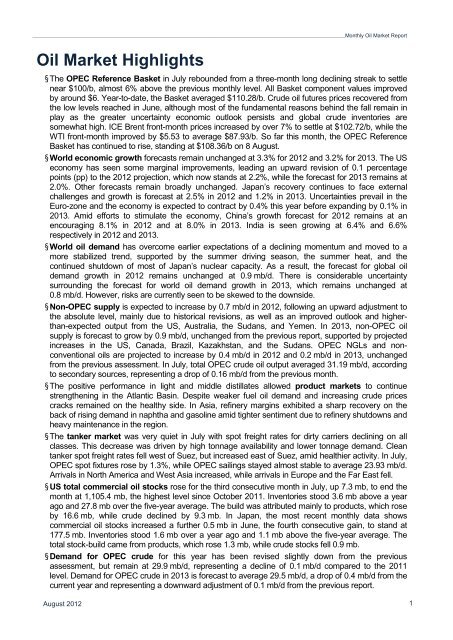You also want an ePaper? Increase the reach of your titles
YUMPU automatically turns print PDFs into web optimized ePapers that Google loves.
_________________________________________________________________________________________________________________________________________Monthly Oil Market Report<br />
Oil Market Highlights<br />
§ The OPEC Reference Basket in July rebounded from a three-month long declining streak to settle<br />
near $100/b, almost 6% above the previous monthly level. All Basket component values improved<br />
by around $6. Year-to-date, the Basket averaged $110.28/b. Crude oil futures prices recovered from<br />
the low levels reached in June, although most of the fundamental reasons behind the fall remain in<br />
play as the greater uncertainty economic outlook persists and global crude inventories are<br />
somewhat high. ICE Brent front-month prices increased by over 7% to settle at $102.72/b, while the<br />
WTI front-month improved by $5.53 to average $87.93/b. So far this month, the OPEC Reference<br />
Basket has continued to rise, standing at $108.36/b on 8 <strong>August</strong>.<br />
§ World economic growth forecasts remain unchanged at 3.3% for <strong>2012</strong> and 3.2% for 2013. The US<br />
economy has seen some marginal improvements, leading an upward revision of 0.1 percentage<br />
points (pp) to the <strong>2012</strong> projection, which now stands at 2.2%, while the forecast for 2013 remains at<br />
2.0%. Other forecasts remain broadly unchanged. Japan’s recovery continues to face external<br />
challenges and growth is forecast at 2.5% in <strong>2012</strong> and 1.2% in 2013. Uncertainties prevail in the<br />
Euro-zone and the economy is expected to contract by 0.4% this year before expanding by 0.1% in<br />
2013. Amid efforts to stimulate the economy, China’s growth forecast for <strong>2012</strong> remains at an<br />
encouraging 8.1% in <strong>2012</strong> and at 8.0% in 2013. India is seen growing at 6.4% and 6.6%<br />
respectively in <strong>2012</strong> and 2013.<br />
§ World oil demand has overcome earlier expectations of a declining momentum and moved to a<br />
more stabilized trend, supported by the summer driving season, the summer heat, and the<br />
continued shutdown of most of Japan’s nuclear capacity. As a result, the forecast for global oil<br />
demand growth in <strong>2012</strong> remains unchanged at 0.9 mb/d. There is considerable uncertainty<br />
surrounding the forecast for world oil demand growth in 2013, which remains unchanged at<br />
0.8 mb/d. However, risks are currently seen to be skewed to the downside.<br />
§ Non-OPEC supply is expected to increase by 0.7 mb/d in <strong>2012</strong>, following an upward adjustment to<br />
the absolute level, mainly due to historical revisions, as well as an improved outlook and higherthan-expected<br />
output from the US, Australia, the Sudans, and Yemen. In 2013, non-OPEC oil<br />
supply is forecast to grow by 0.9 mb/d, unchanged from the previous report, supported by projected<br />
increases in the US, Canada, Brazil, Kazakhstan, and the Sudans. OPEC NGLs and nonconventional<br />
oils are projected to increase by 0.4 mb/d in <strong>2012</strong> and 0.2 mb/d in 2013, unchanged<br />
from the previous assessment. In July, total OPEC crude oil output averaged 31.19 mb/d, according<br />
to secondary sources, representing a drop of 0.16 mb/d from the previous month.<br />
§ The positive performance in light and middle distillates allowed product markets to continue<br />
strengthening in the Atlantic Basin. Despite weaker fuel oil demand and increasing crude prices<br />
cracks remained on the healthy side. In Asia, refinery margins exhibited a sharp recovery on the<br />
back of rising demand in naphtha and gasoline amid tighter sentiment due to refinery shutdowns and<br />
heavy maintenance in the region.<br />
§ The tanker market was very quiet in July with spot freight rates for dirty carriers declining on all<br />
classes. This decrease was driven by high tonnage availability and lower tonnage demand. Clean<br />
tanker spot freight rates fell west of Suez, but increased east of Suez, amid healthier activity. In July,<br />
OPEC spot fixtures rose by 1.3%, while OPEC sailings stayed almost stable to average 23.93 mb/d.<br />
Arrivals in North America and West Asia increased, while arrivals in Europe and the Far East fell.<br />
§ US total commercial oil stocks rose for the third consecutive month in July, up 7.3 mb, to end the<br />
month at 1,105.4 mb, the highest level since October 2011. Inventories stood 3.6 mb above a year<br />
ago and 27.8 mb over the five-year average. The build was attributed mainly to products, which rose<br />
by 16.6 mb, while crude declined by 9.3 mb. In Japan, the most recent monthly data shows<br />
commercial oil stocks increased a further 0.5 mb in June, the fourth consecutive gain, to stand at<br />
177.5 mb. Inventories stood 1.6 mb over a year ago and 1.1 mb above the five-year average. The<br />
total stock-build came from products, which rose 1.3 mb, while crude stocks fell 0.9 mb.<br />
§ Demand for OPEC crude for this year has been revised slightly down from the previous<br />
assessment, but remain at 29.9 mb/d, representing a decline of 0.1 mb/d compared to the 2011<br />
level. Demand for OPEC crude in 2013 is forecast to average 29.5 mb/d, a drop of 0.4 mb/d from the<br />
current year and representing a downward adjustment of 0.1 mb/d from the previous report.<br />
<strong>August</strong> <strong>2012</strong><br />
1
















